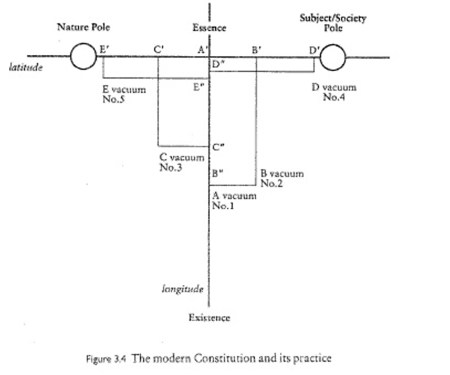 In We Have Never Been Modern, Latour adopts a cartographic metaphor to explain the stabilization of the Nature-Society duality from unstable events, or the trajectory from A” to D” marks, as Latour puts it, ‘the gradient that registers variations in the stability of entities from event to essence.’ (p. 85). Adopting Spinozist language, Latour will later clarify his ontology; namely:
In We Have Never Been Modern, Latour adopts a cartographic metaphor to explain the stabilization of the Nature-Society duality from unstable events, or the trajectory from A” to D” marks, as Latour puts it, ‘the gradient that registers variations in the stability of entities from event to essence.’ (p. 85). Adopting Spinozist language, Latour will later clarify his ontology; namely:
…the immanence of naturing-natures [Nature] and collectives [Society] corresponds to a single region: that of the instability of events, that of the work of mediation…If we add to the official, stable version of the Constitution [i.e., the Nature-Society divide or gap] its unofficial, ‘hot’ or unstable version, the middle is what fills up, on the contrary, and the extremities [the Nature and Society poles] are emptied. (ibid. 86-7).
A very similar point is made in Latour’s early work, Laboratory Life, when discussing the status of scientific objects, in particular TRF (thyrotrophin releasing factor), he argues that ‘the solidity of this object, which prevented it from becoming subjective or artefactual, was constituted by the steady accumulation of techniques.’ (127). A consistent theme for Latour, then, though he did not always use the same terms to detail it, is that events and objects are not to be confused with one another even though they are not fundamentally distinct, much less different in kind. Rather, objects are stabilized events; or, adopting Latour’s own metaphor, objects are ‘the cooled down continents of plate tectonics.’ (Never Been Modern, 86). Objects are thus inseparable from their unstable networks, and even though an object may be particularly stable and even lionized as a textbook fact, it may lose allies to another object that, through a ‘steady accumulation of techniques’ and alliances, displaces it. Latour gives the example of how prior to Watson chemists preferred, and textbooks stated as an established fact, that the four DNA bases were in the enol form which subsequently made it more difficult for Watson to cast doubt upon it and put forth the case that it was in the keto form instead. (Lab Life, 243). A Latourian ontology is monistic, therefore, in that there is nothing but objects and events – the middle is filled and the poles are empty as he put it – but this is not a stable monism of autonomous objects and lawful events; rather, it is an aberrant monism that continually moves between stable natures and collectives and unstable, aberrant events. What implications does this have for placing Latour within the OOO camp? It seems to place him on the margins, though I’m not committed to this.